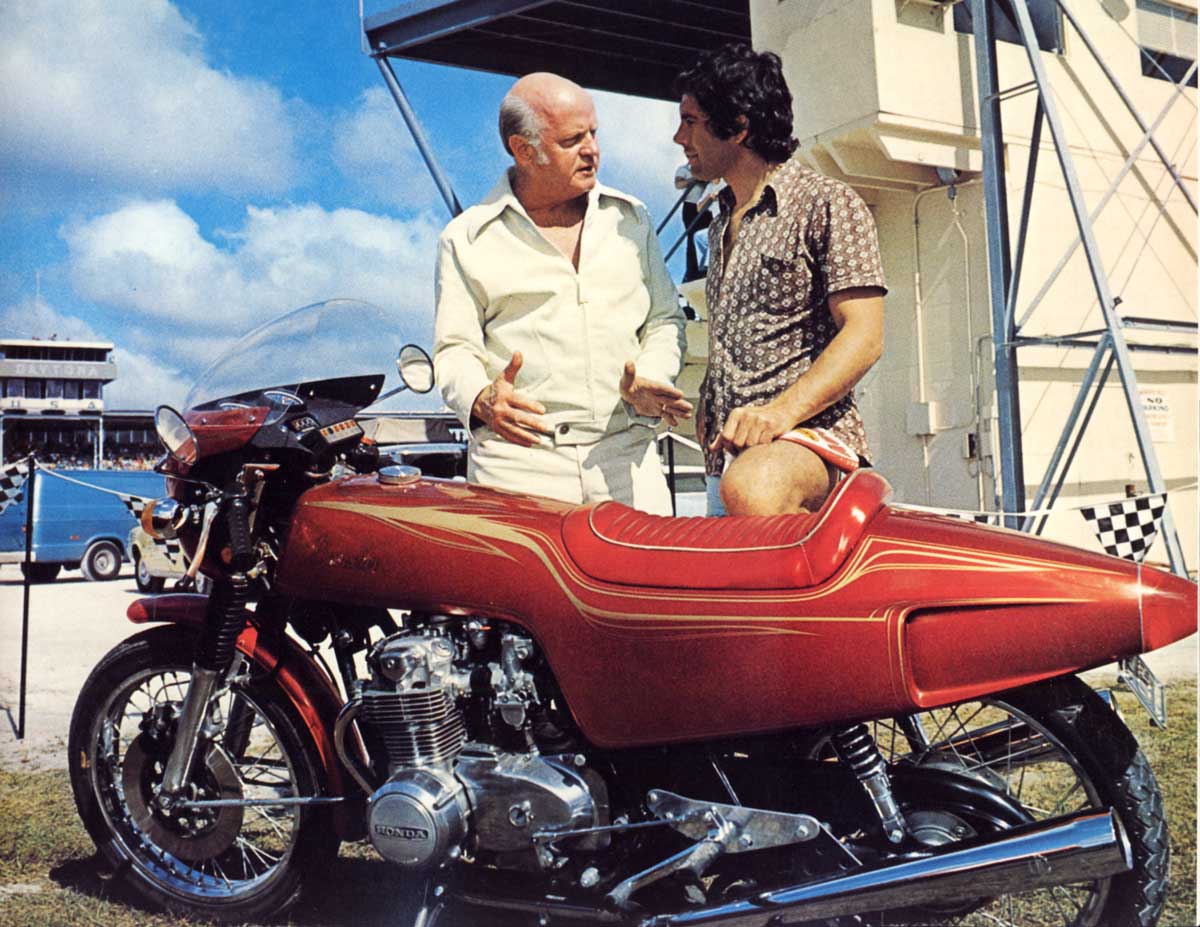
Bill Mitchell’s Fast Living on Two Wheels
by Jack K. Yamaguchi
Printed in Car Styling No, 7, August 1974
Thanks to John Houlihan.
WARREN, Michigan, the home of the mighty General Motors Technical Center. A few miles from the sprawling GM establishment, you come to a sleepy shopping area with rows of flat tiny shops, a landscape so familiar of Suburbia, U.S.A. A strange shop occupies one end of such a building. Next to a dry cleaner and a florist which are very much in business, the shop carries no sign as to its ownership or type of business, and its facade is thickly blinded. It is inhabited all right, as men are occasionally seen going in and coming out of the front door. They are a mixed lot of people; an immaculately dressed elderly gentleman of obvious affluence who exudes the natural air of high authority, younger men in casual attires, and a few in working coveralls. Modes of their transportation are as varied, from rare and racy sports coupes to a wildly painted pickup with fat off-road tires. The shop is mysterious to outside eyes to a degree that, as a regular commuter wryly concedes, it may even look a bit sinister, like a secret operational center of high stake bookies!
You may happen to spot the Chevrolet pickup with fire-breathing dragons painted on its sides in front of the shop, loading or unloading a couple of motorcycles. If you are a regular subscriber of HOT ROD, you will drool at the pickup which is appropriately dubbed “Dragon Wagon.” If motorcycling is your favorite cup of tea, you will be spellbound at the sight of those fabulous super bikes. Your mind races through memories, but can’t place them in any motorcycle shows or in pages of magazines; you have never seen anything like them. Beauty of the Warren location is that pedestrian traffic is so sparse that crowds are seldom formed at the shop, so that its inhabitants can carry on their works undisturbed. The shop belongs to Bill Mitchell, and it is his studio-cum-workshop-cum-stable for his fantastic super bike collection.
Bill Mitchell, car buff, motorcycle enthusiast, collector, executive, and super designer. At the General Motors Technical Center a couple miles away, he is William L. Mitchell, Vice President of GM Design. Mitchell is the generalissimo of GM’s world design functions and activities, automotive and otherwise. He is undoubtedly the most powerful and authoritative single individual in the world of industrial design. I am not going to relate on Mitchell of GM, as readers are no doubt well versed on his personality and achievements, which have been ably introduced by our colleagues Karl Ludvigsen and Eoin Young in Car Styling No. 2. Still, on arrival at Warren on a bitterly cold April morning, I had to drive once around the outer perimeter of the GM Technical Center to prepare myself before meeting one of its top resident executives. I was duly impressed by its vastness, and even more so by the sumptuous suit of offices occupied by the host.
He was most hospitable and kind, yet his presence there was majestic. He obviously chose his weapon well, a blue Camaro of circa 1973 from among many an exotic looking machinery, most of which I had seen at various motor shows, exhibitions and in pages of automobile publications, in the GM Design garage. A hidden electronic eye opened the garage door silently, and we slid out. On the first straight, the driver’s right foot pressed against the floor, and things started happening. This was no ordinary Camaro SS, its hood housing an all aluminum Can Am 7-liter V8! Those GM designers were most considerate and provided a rev counter on the hood for the exclusive benefit of the front seat passenger the driver had his own on the instrument cluster, and I had never seen the needle of a rev counter in an American V8 car swing so fast on its dial. Whoever said a lazy V8! The compact catapulted with its radials as fat as racing rubber spinning wildly.
I was sitting next to Bill Mitchell, the ENTHUSIAST. In no time at all, we were at the tiny shop, and there I was treated to the sight of his pride-and-joys, that wonderful collection of cafe racers. The fleet of super bikes housed in this small studio-shop will excite any motorcycle enthusiasts, especially those who love fast road bikes and road racing. An MV Agusta 7508S Four, Honda four cylinder trio comprising of a CB350, a CB500 and a Dunstall modified CB750 (said to have a 900 cc motor,: a Laverda 750SF, a Moto-Guzzi V7 Sport, a Ducati 750 Vee-twin, a Yamaha XS650. And there are three fabulous racing bikes, a very special Harley-Davidson 1000, a Yamaha TZ750 Four .one of the 200 machines built, and a Yamaha TR3 350 twin. And most of them have been given the magic Mitchell touch.
Honda CB550 Banshee
Half-fairing which incorporates the headlamp, turn signals and a read-out panel for instruments and shift selector turns with the racing type clip-on handlebars. Mitchell believes this is a better arrangement for a road machine than a full fairing of a pure racer. Bill Mitchell with Giacomo Agostini, winner of the 74 Daytona 200, at Daytona.
Two wheeler version of “Banshee,” based on a Honda CB500 Four. Banshee is a supernatural being supposed to warn by its wails of approaching death, according to the trish and Scot. This particular Banshee lets out beautiful sounds full of life from its tuned exhaust system, which consists of single muffler on each side. The bike sounds more like a mini V8 at lower rpm, and the exhaust system is said to give out 5 additional hp.
Banshees on two and four wheels. The stylish coupe !s a GM prototype first shown at the New York Auto Show. Both vehicles are painted in a brilliant special Candy Apple Firefrost. A very handsome and matching pair!
Fast Living, cont’d.
Here I must register one thing, which was emphasized by Bill Mitchell at his Warren studio-shop. That General Motors has no interest whatsoever in developing or producing motorcycles, and it has nothing to do with Mitchell’s super bike projects. Now, if you are seeking an audience of William L. Mitchell, Vice President Design, in search of his thoughts and philosophy on current GM and other automotive matters, you are required to follow the corporate public relations channel, and probably will be accompanied by their able press man if the Veep agrees to see you. But the super bikes are Bill Mitchell’s own properties and his personal pet projects. The communication can be had between the two enthusiasts, and as it turned out, be more intimate and personal : my oriental modesty and honesty concede that Bill Mitchell, one enthusiast, belongs to the “those who can, do” group, while yours truly is one of “those who can’t do it, just write about it.”)
The Warren studio-shop is run on Bill Mitchell’s personal funds, and obviously seeks no profit. His small force of men are part timers, whose time spent at the shop is compensated by Mitchell. He is naturally in an ideal position to recruit such part timers, and those GM designers and craftsmen who answer Mitchell’s call are auto and bike buffs. At present the GM Design is operating round the clock, and staff are working in shifts, so his collaborators can always find a couple hours on their off work time to come to the studio-shop. Winter in Detroit is most unkind and gloomy, which may be a natural advantage for the super bike operation; the “boys” may find it better to work on their and their boss’s pet projects at the shop, rather than go out in this miserable climate! This must be an efficient season for the Operation Super Bikes and I suspect the same can be true at GM and elsewhere. That man Henry was a devilish schemer, choosing Detroit as the Motor City, U.S.A.
Yamaha XS650 and Kawasaki Z1900
Like the two Banshees, this Pontiac Trans Am matches two superbikes, a Yamaha XS650 Twin and a Kawasaki Z1 900 DOHC Four in the Mitchell stable. They are all finished In a special black with gold flake and gold inlaid stripes. The “Kawa” appears to be stock, except the distinctive paint work. Kawasaki has shown its flair in styling its faster roadsters, and it may be interesting and significant that the Super Designer did not touch the basic shape. As many riders have found out, the ZI was a bit handful even for an enthusiast of Mitchell’s skill and love, and he parted with the bike.
Yamaha XS650 Twin a la Bill Mitchell. The big vibrant twin from Hamamatsu. Mitchell praises its excellent handling qualities. A marked contrast to the Honda Banshee, but the Yama is a slim and integrated conversion of the original theme. 6 : A once piece body was purchased from the Fiberglass Works in California, mecca of cafe racers, was cut in half and completely redesigned by Mitchell and his staff. it is a graceful machine; mild yet distinctive in Mitchell’s own description.
Fast Living cont’d.
Mitchell’s super bikes belong to the “cafe racer” school, which has become such a popular fad in America and Europe. They are road bikes but with racy looks. But the works of the super designer and his staff are definitely more than two wheeled hot rods. I believe they are quite significant in motorcycle design of today and future. They are one-off bikes, and as such have no commercial consideration. Bill Mitchell’s strong personality and individualistic tastes are therefore expressed on these bikes more vividly. Bill Mitchell’s approach is total involvement in his vehicle, be it on four wheels or two. He insists, “You can tell from what it looks like whether the guy was an enthusiast or just a product man doing the job from a distance.” Every one of his super bikes is his personal mount. Riding a super bike at its proper gait is the most effective way to blow off the stress and pressures he has to take as the supreme commander of the GM Design who carries awesome responsibilities. He would pick up his fabulous MV Agusta Four, assume a low racing posture, and do a quick lap on the test track in the Tech Center. Bill Mitchell understands and loves that beautiful “oneness” of “you, the bike and the road.” This total concentration, he finds, unwinds his tension. It is a balm and best nourishment.
Details
Cockpit of the CB500 “Banshee.” Mitchell believes that a half fairing incorporating the headlamp which steers with the handlebar is the answer for windcheating on the roadster. Another Mitchell touch is the gear position indicator panel. He added a digital display system could be neater.
Initials of the super designer, “W.L.M.” on the filler cap of the Honda CB500 Four “Banshee. ”
Rear cowling of the CB500 “Banshee” has integral direction signal indicators. These lamps work like an automobile system. All three lamps light up when switched on, and the directional signal increases intensity when turned on. The layout is definitely neater to look at, and obviously enhances safety aspect of rear lighting.
Fast Living cont’d.
Mitchell’s super bikes belong to the “cafe racer” school, which has become such a popular fad in America and Europe. They are road bikes but with racy looks. But the works of the super designer and his staff are definitely more than two wheeled hot rods. I believe they are quite significant in motorcycle design of today and future. They are one-off bikes, and as such have no commercial consideration. Bill Mitchell’s strong personality and individualistic tastes are therefore expressed on these bikes more vividly. Bill Mitchell’s approach is total involvement in his vehicle, be it on four wheels or two. He insists, “You can tell from what it looks like whether the guy was an enthusiast or just a product man doing the job from a distance.” Every one of his super bikes is his personal mount. Riding a super bike at its proper gait is the most effective way to blow off the stress and pressures he has to take as the supreme commander of the GM Design who carries awesome responsibilities. He would pick up his fabulous MV Agusta Four, assume a low racing posture, and do a quick lap on the test track in the Tech Center. Bill Mitchell understands and loves that beautiful “oneness” of “you, the bike and the road.” This total concentration, he finds, unwinds his tension. It is a balm and best nourishment.
Moto Guzzi V7 Sport 750 Twin and Laverda SF750 Twin
Moto Guzzi V7 Sport 750 cc Twin, also finished in the Transam-Yama-Kawa black with gold metal flake. This bike again retains its original shape, except a new tail section. On the stock Guzzi, the black frame contrasts rather sharply against lighter gas tank and sidecovers, and contributes to a cluttered look. The new finish and distinctive striping has successfuly eased this impression. The V7 Sport is a 125 mph machine, propelled by its 72 bhp/7000 rpm 2-cylinder engine.
Laverda SF750 Twin, another Italian super bike from a relatively new factory, whose parallel SOHC 2-cylinder engine owes its mechanical layout and unique Square-Cut appearance to the immortal Honda C70 of circa 1958 (memorable first that a Japanese product was copied! The rest of the machine is, however, purely functional and exciting Italian, the essence of a fast roadster. Again Mitchell honored the basic shape, except a tall section and a sparkling gold metal flake with white striping.
Fast Living cont’d.
The motorcycle is primarily for the rider, and for him alone. And I was happy to see that Bill Mitchell subscribed to this principle, as most of his bikes were single-seaters, with pillion footrests removed. And their seats were lowered so that the rider could easily assume a low riding position. On the mechanism of the motorcycle, Mitchell is thoroughly practical and realistic. He praises Honda for the adoption of an electric starter on a super bike, the CB750 Four, which really started the current vogue. He insists on an electric starter on every one of his bikes, since he has had his ankle broken by a back-kicking starter. And sometimes a traditional house obliges with Mitchell’s desire, Norton-Villiers being one.
He has long admired the superb road holding and handling of the lean Norton twin, and the British factory has finally agreed to specially prepare a twin with an electric starter. Such is the respect this super designer and enthusiast commands. Another Mitchell feature is a read-out panel for the instruments and shift selector position, incorporated in one of the latest works, the Honda CB500 based Banshee. The rider normally “feels” which gear he is in. On a bike fitted with closely spaced multi gears, he could easily misfeel the position. Mitchell believes in the surer read-out panel, which is an obvious safety item. Bill Mitchell does not hesitate in swapping equipment and accessories.
For example, he would fit Italian horns onto a Japanese bike, simply because they are better. So called purists may shrug their shoulders at such practices, but Mitchell’s aim is to combine the best of everything to make his bikes better. Bill Mitchell’s motorcycles are all road models. He took to a trail run, at the invitation of a couple of intrepid testers from an American motorcycle magazine. “Suddenly the trail disappeared, and there was a cliff in front of me. Those guys rode down, so I followed,” muses Mitchell who successfully answered the challenge.
But for him, road sportsters are the motorcycles, and road racing the competition. He is a regular commuter to the annual Daytona 200, where he would have his own paddock for his personal fleet of bikes and transporters and a GM prototype car, this year a four wheeled version of Banshee. Last year he was at the Imola race. His close association with personages in the automobile racing is well known, among whom are Jackie Stewart, Stirling Moss, Alice Caracciola, the widow of the famous German driver. Likewise, he has friends among the motorcycle fraternity, the reigning world champion Giacomo Agostini being a favorite one. Mitchell is interested in Japanese reaction to Agostini on Yamaha, and to the Daytona and Imola events where Ago won convincingly.
MV Agusta 750S Four, Honda CB750 Four “Black Knight”, and Honda CB 350 four
Most fabulous among Mitchell’s collection of super bikes, the MV Agusta 750S Four. This beautiful DOHC transverse 4-cylinder engine has a Grand Prix racing ancestry that dates back to 1950. Earlier MV Fours used in racing also had a shaft drive layout, which was adopted when the factory introduced a road going version (current racers use chains.) The original engine was designed by Ing. Remor, who had been responsible for the Gilera four cylinder racers, which accounted for their almost identical appearances. The 750 cc unit in S tune produces 76 bhp at 7900 rpm. The Agusta can be set up two ways, with or without full fairing. This is without fairing.
Side view does not convey the massiveness of the 4-cylinder engine. It is an enormously wide unit, and the fuel tank has a wide lower bulge in an effort to cover up some of its heaviness. Mitchell, believer in a lean and hungry look, tried to reduce the fat look of the bike, but could do little about the actual width of the power unit. So he shaped a tail section to carry on the tank’s theme, thus shifting the onlooker’s attention which otherwise would have been pinned on the engine/tank area.
Mitchell’s pride and joy, “Black Knight” based on a Honda CB750 Four, granddaddy of the super bike movement. This bike is from Dunstall of England who manufacturers special conversion kits for motorcycles. Like the CB500 Banshee, the standard four mufflers I have been replaced by two mufflers, one on each side, which add 5 hp.
The fairing is a Dunstall production item, with a pair of Formula I racing mirrors added by Mitchell. A complete new seat/tail section was designed which incorporated vee type tail and stop/tail light. The bodywork is a bit heavier than the others in the stable, but quite appropriate for the gallant knight in full armour.
“Ideal city bike,” describes Mitchell of the Honda CB350 Four. This spritely runabout is given a typical Mitchell tail with integrated tail light. A stock touring handlebar is retained for works in town. The gas tank is stock but looks much cleaner with simple and effective Striping.
Fast Living cont’d.
Mitchell likes lean bikes, the special electric start Norton being one which he looks forward to getting soon. Lean and agile machines with superior road holding and handling. Multis like the Honda 750 Four and the MV 750 are beautiful machines with screams like a well tuned Ferrari V12 and the smoothest power delivery. They are wonderful on open roads. But on gently undulating and winding roads, a lighter and leaner machine could show its heel to the heavy. A very special Yamaha twin currently being modified is an excellent example of the new Mitchell concept. This is a Yamaha TR3, that famous giant killer, whose racing power plant is replaced by a road version, and which is fitted with legal street equipment including twin lens taillight. This is a fascinating exercise that whets the appetite of a light weight enthusiast. A weapon you can use to slay Goliaths!
Details
Honda CB500 Four “Banshee.” The rear end has three lights, the center one a bullet shaped, wth 180° of light distribution. On each side of the body is a recessed light which acts as turn signals. All three lights act as running and brake lights. Obviously this is a future trend Mitchell will follow through, as seen in a Ducati conversion.
Honda CB350 Four’s clean tail section.
BMW R75. A large but smart rear body with neat tail light with BMW emblem bedded in. An interesting contrast to the latest R9OS which features a heavy looking tail piece with bold letterings. Silver is one of Mitchell’s favorite colors.
Yamaha XS650. Stock tail light is half covered by the tail nacelle. This treatment is repeated on a TR3 based roadster currently being modified.
Rear guard of the Black Knight ts taller and heavier, with large tail light.
MV Agusta Four has a recessed tail light assembly with horizontal louvers which adds character to the overall bike.
Fast Living, cont’d.
Work is also on progress on a Ducati 750 Vee-twin, which is a slim bike despite its large cubic capacity with its cylinders placed longitudinally in the frame. Then there is another major project on the drawing board with the basic bike already in the shop. Up to now, the Mitchell stable consisted of redesigned production bikes. Mitchell and his staff studied the original forms of those motorcycles, eliminated clumsiness, corrected compromises and refined shapes and lines. Take the Honda 350 Four, Laverda and Moto-Guzzi, which retain the basic forms of the production versions, have been given Mitchell’s own rear “bodies” which integrate taillights, and finished in sparkling Mitchell color schemes. Resultant changes are truly dramatic, hiding some of the original awkwardness and supplementing their mechanical beauties.
By comparison, the CB750 “Black Knight” and the Yamaha XS650 look very much divorced from the original shapes, but these also are based on “over-the-counter” cafe racer kits. The former is a redesigned Dunstall-Honda model, and the latter has a reshaped Fiberglass Works (a California based speed shop body, both of course refined to Bill Mitchell’s exacting demands. The new Harley 1000 project is more Mitchell than anything that has been redesigned and built. It will have a track racing frame fitted with an electric start 1000 cc Vee-twin engine, a Ceriani front fork, special Goodyear racing tires of 3.2518 front and 3.5018 rear sizes on famous Borrani spoked wheels. A one-piece body with partial fairing incorporating the headlamps and instrument panel is still on the drawing board; it should be the wildest thing ever appeared on two wheels. Pity I cannot have a few sketches of it in this issue. It will be painted all white. Dave North, Mitchell’s assistant in the Operation Super Bikes, and a Cadillac-Oldsmobile designer, told me confidently, “They are getting better.” To which Bill Mitchell added, “Otherwise, it’s not worth doing it.” LONG AND FAST LIVE, BILL MITCHELL’S SUPER BIKES!
Ducati 750SF, Yamaha TR3, Yamaha TZ750, and a Harley Davidson Flat Track Bike
Work in progress, a Ducati 750SF Vee Twin. A proper clay model is shaped before a body is actually built. The design follows the theme of the Honda Banshee tail.
Another exciting project. This is a Yamaha TR3 racing bike, whose engine has been replaced by a road-going RD350 unit. “Light and slim sportster with good frame and superb suspension can slay bigger displacement machines, on certain types of roads,” is Bill Mitchell’s concept, which is being materialized. Indeed, a very potent David of a motorcycle! Separate oil tank is in the tail of the bike as in the racer, and a clever one touch cover has been devised. 3 : Two fantastic racing machineries Bill Mitchell has acquired recently. Harley- Davidson in the foreground is a special frame designed for flat track racing with racing suspension. A Ceriani front fork is also added, and the bike rides on special Goodyear racing tires (3.25 X18 front, 3.50 X 18 rear.) A one-piece body with wild front fairing is now on the drawing board.
Behind the Harley is a Yamaha TZ750 water-cooled four, one of the batch of 200 bikes produced. Similar machines won both the Daytona 200 and the Imola Formula Libre race in the hand of Giacomo Agostini. Mitchell hasn’t formulated his plan on this probably fastest thing on two wheels.
Dragon Wagon
“Dragon Wagon” can carry two super bikes on specially made sliding platforms. The bikes are fastened securely with belts and locking bar.
Loading and unloading can be done by single adult. Step one is to pull the bike, which slides out easily on rollers.
The bike ts put down gently on the hydraulic lift. The Chevrolet pickup itself can take the bike’s weight which ts overhung in this position. No jacking of the vehicle is required.
The motorcycle is on the ground now. The car behind Mitchell is on this occasion his personal transport, which brought us from the GM Tech Center to his shop in Warren. It is a GM styling exercise on the Riviera theme with lowered roof. It is a dynamite, too.
Unbuckle the belts and drop the trailing end of the platform, and the bike can be rolled out, ready for the road.
Note: Kim Boose commandeered the Dragon Wagon to transport my new Kawasaki home. Pretty cool! See more in the Dean’s Garage book.


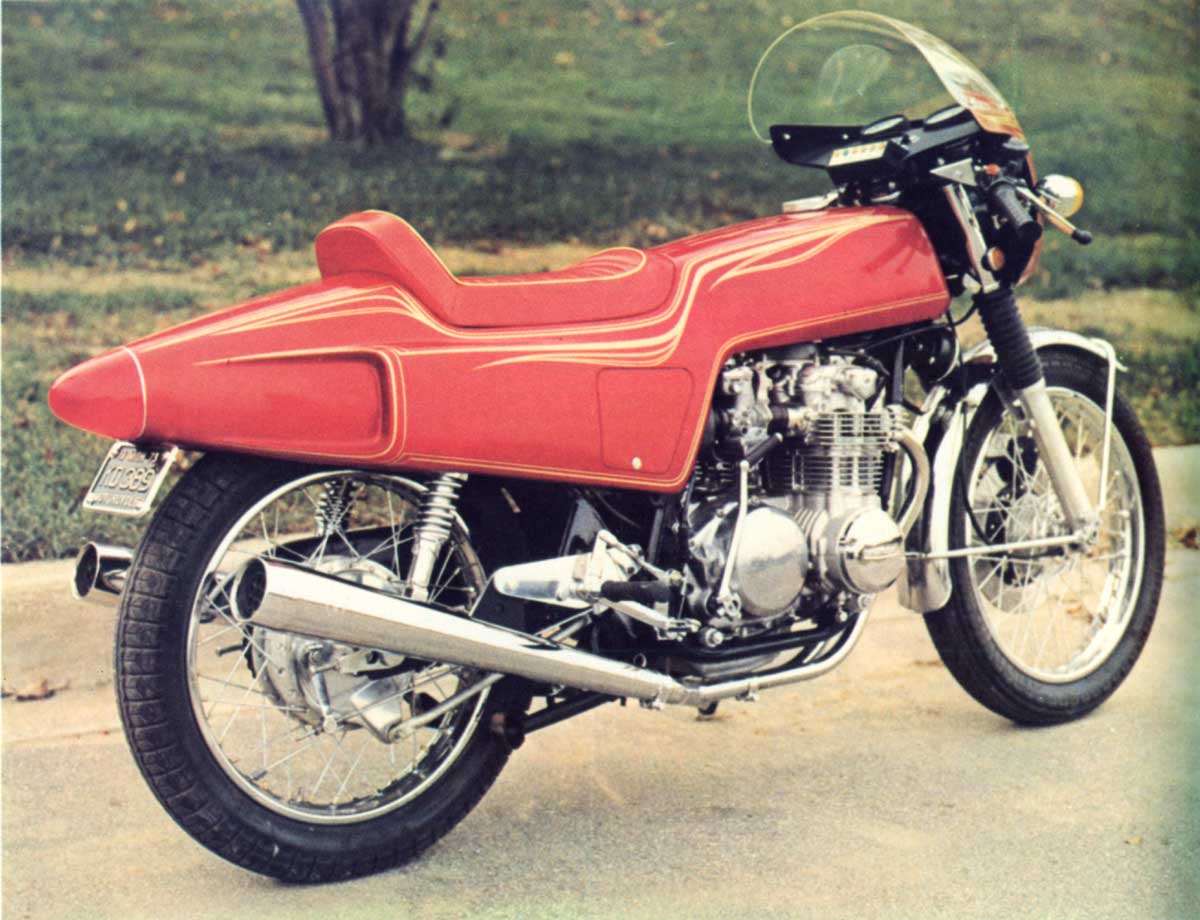
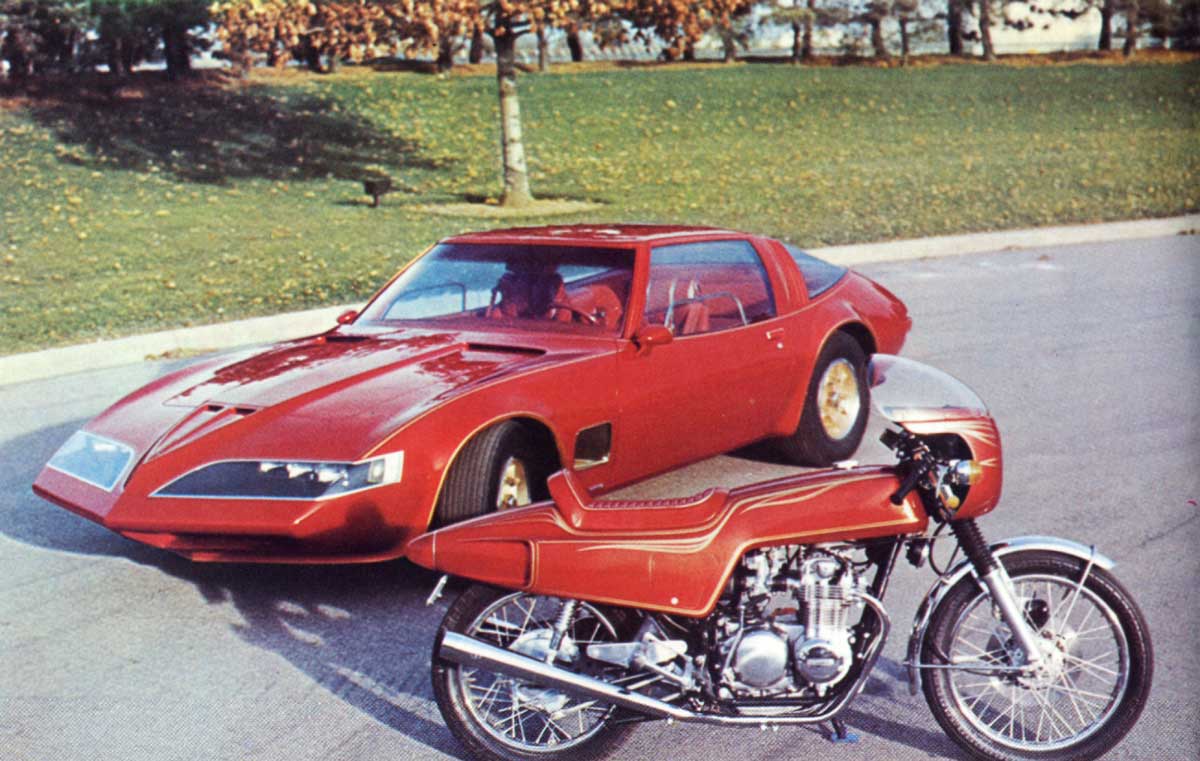
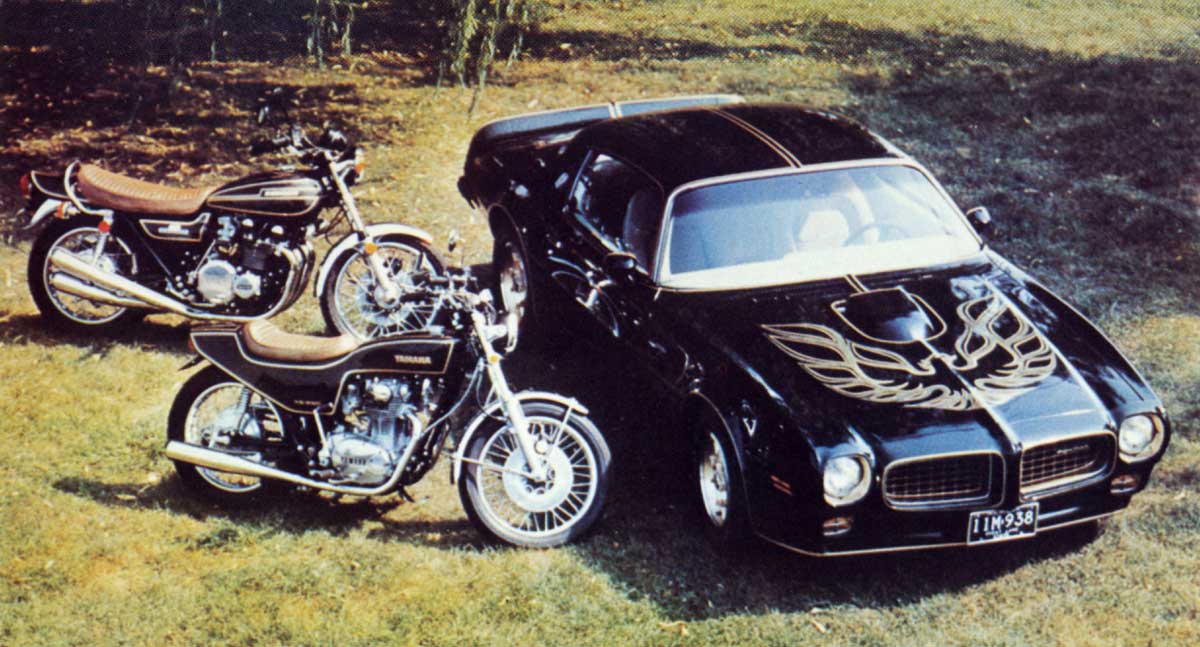
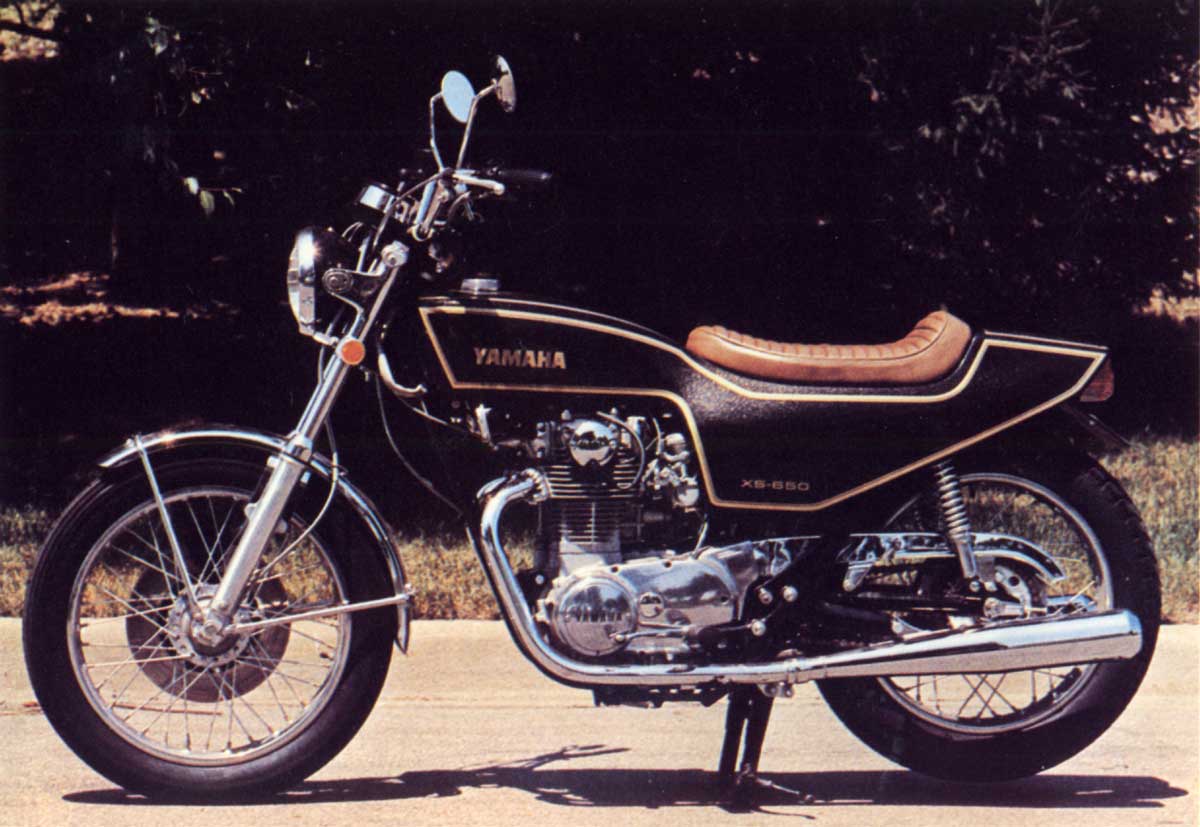

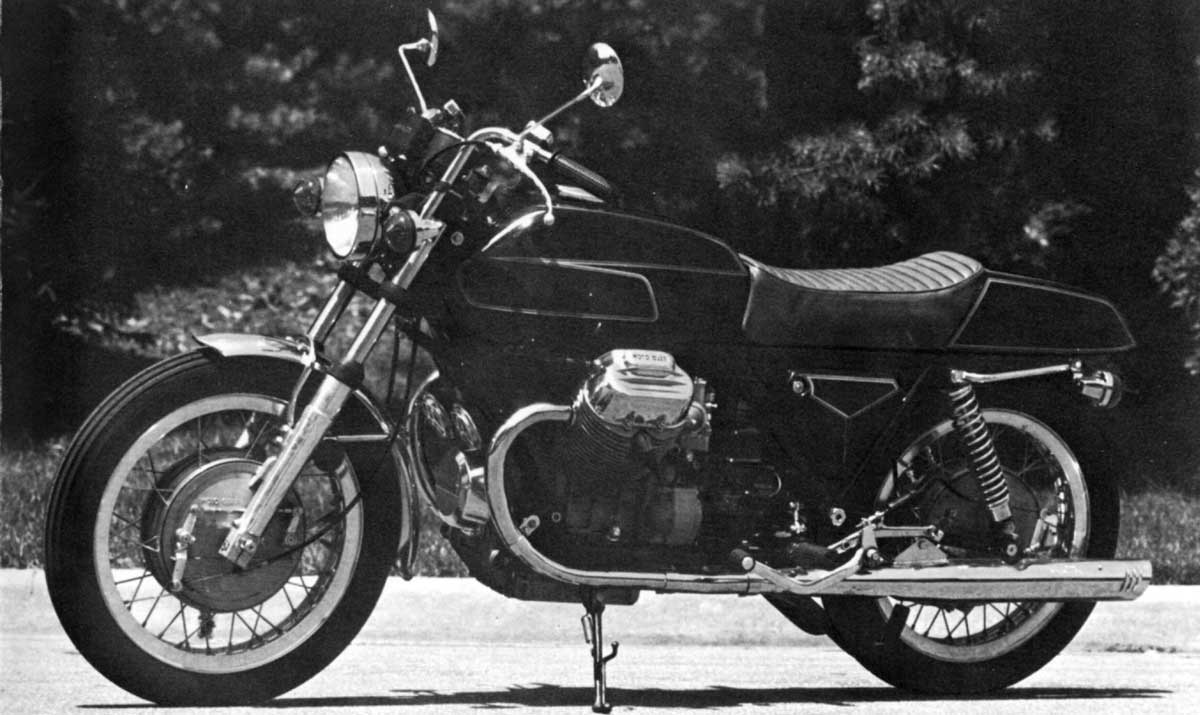
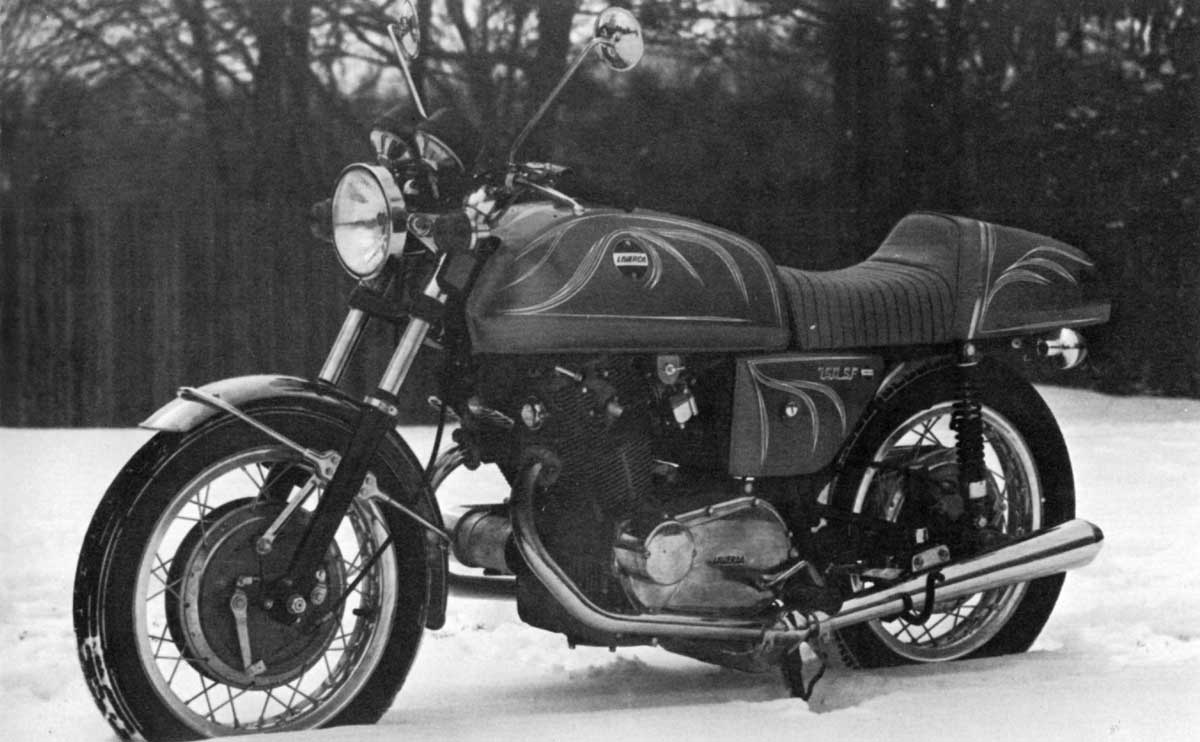
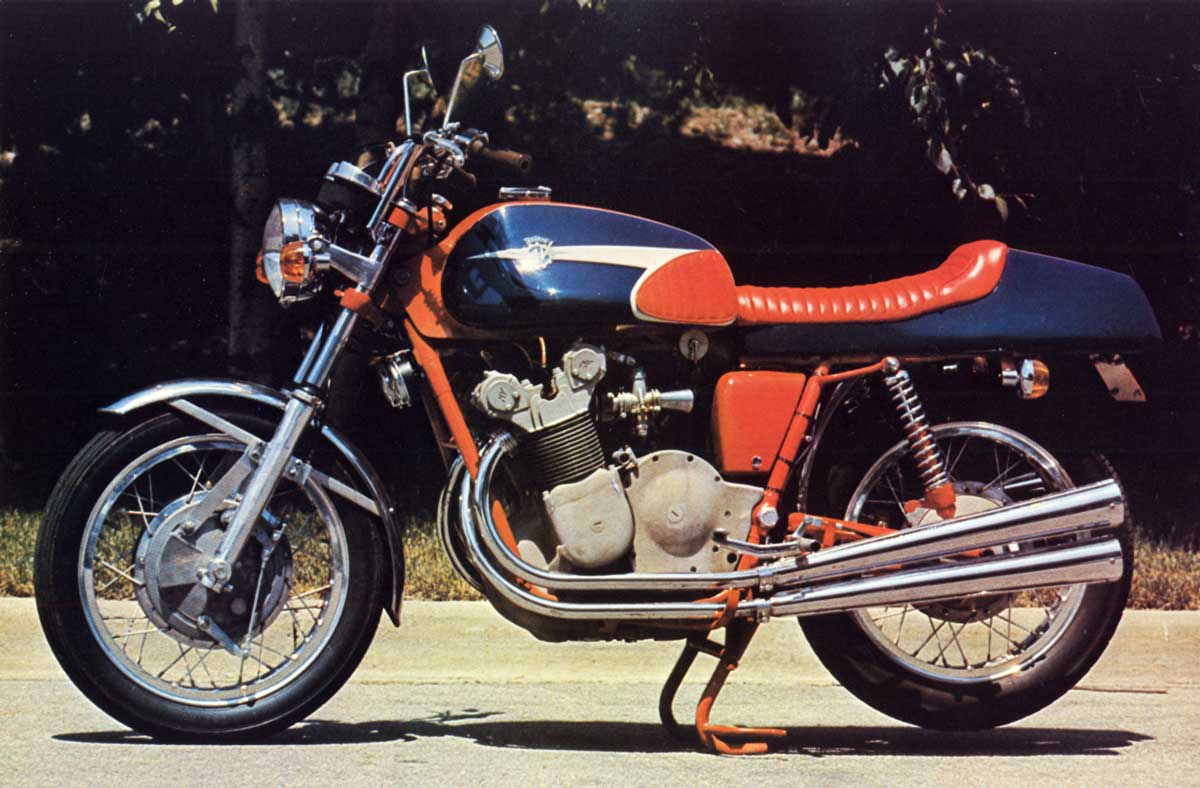
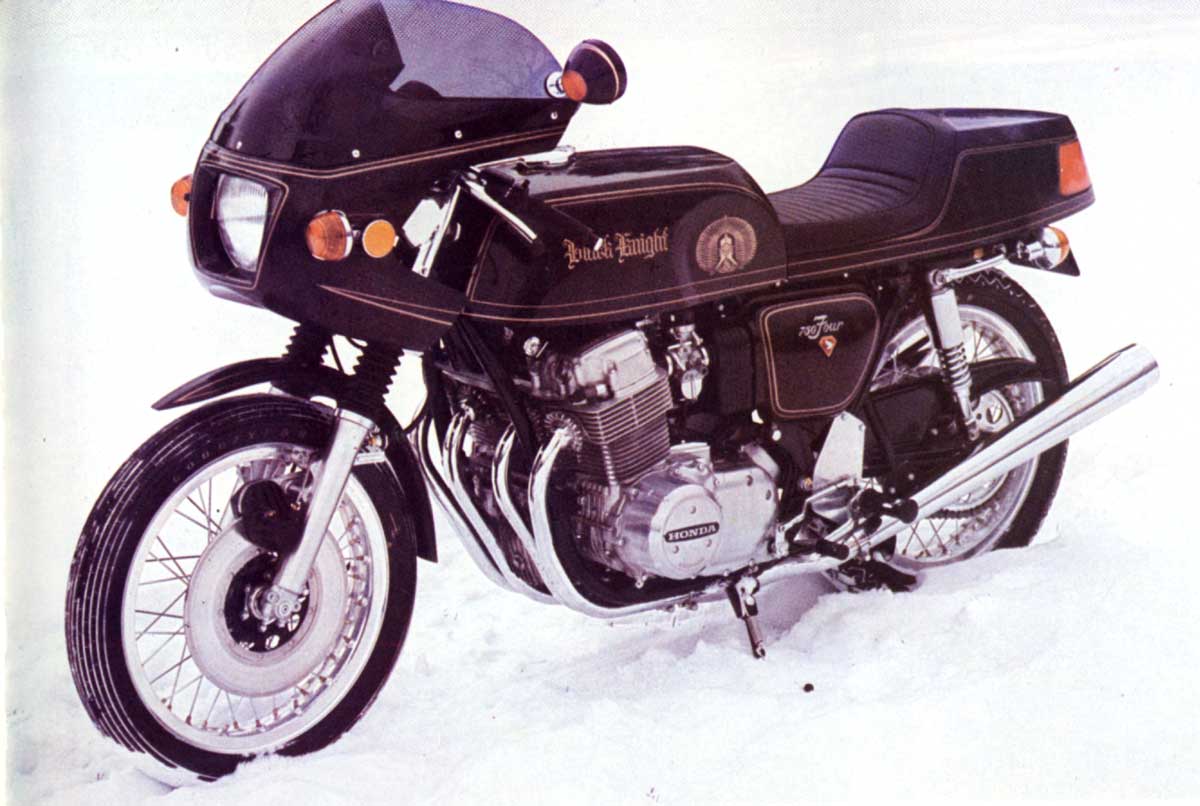
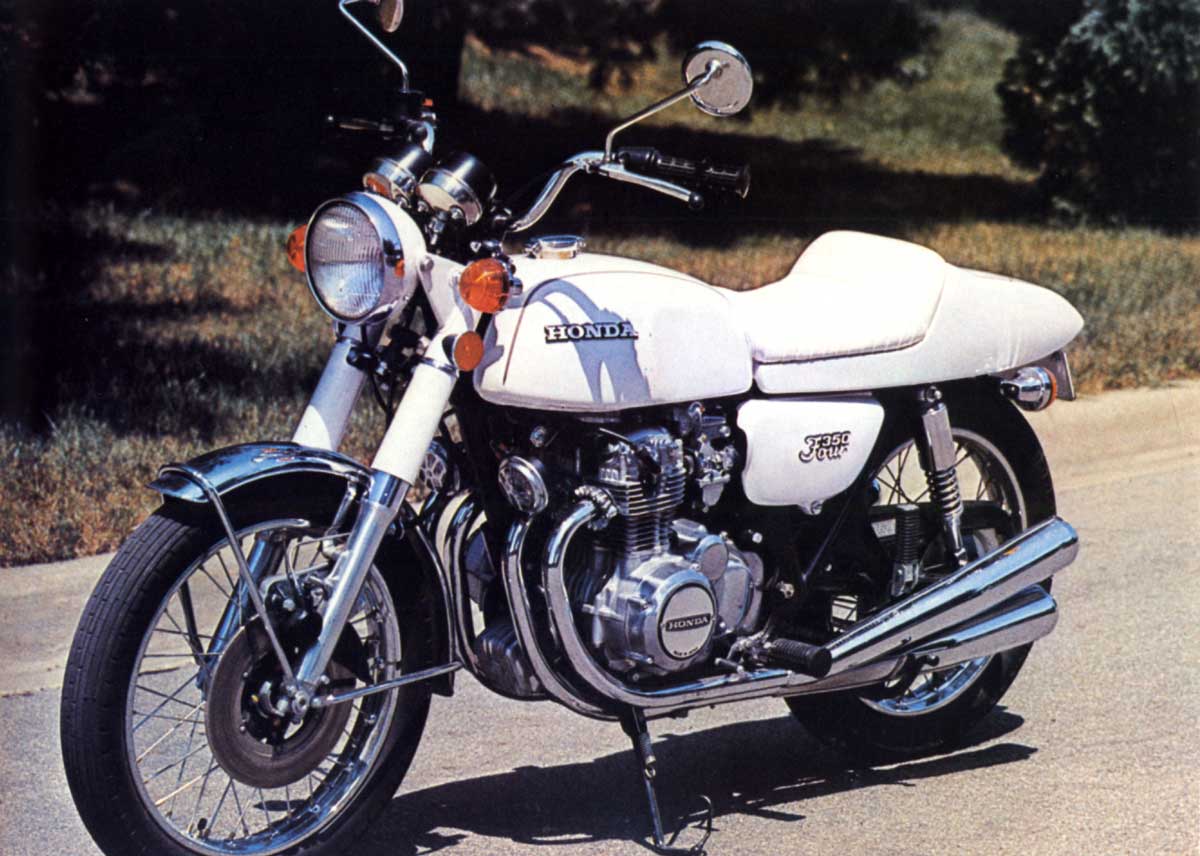
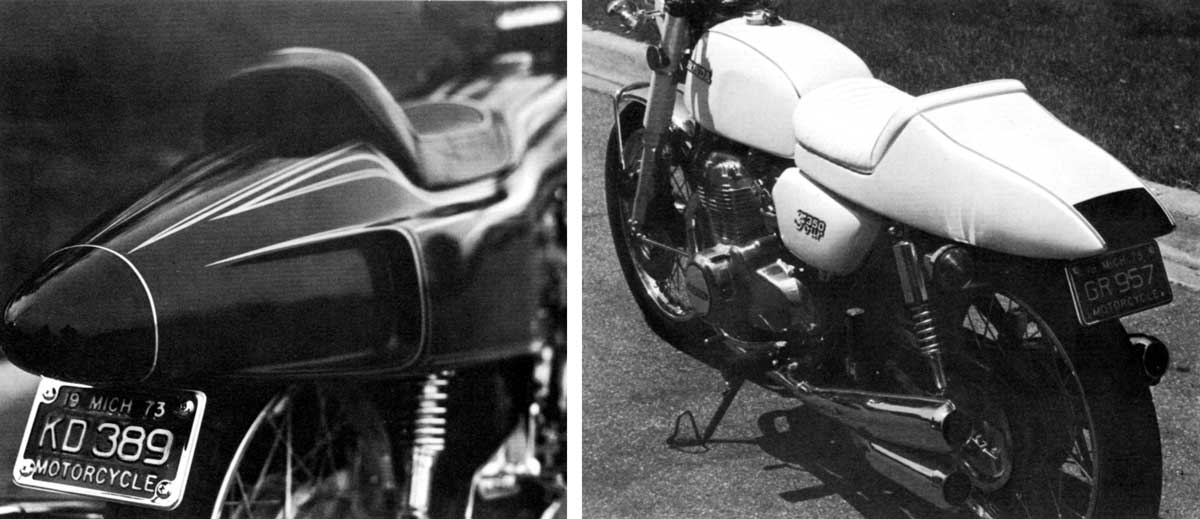
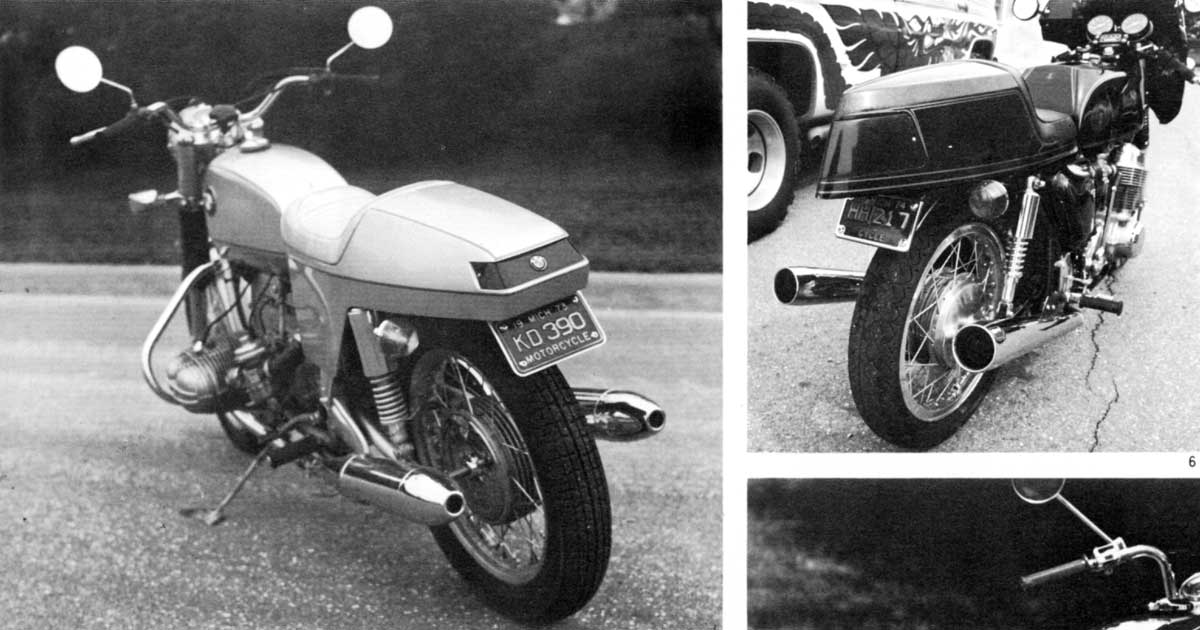
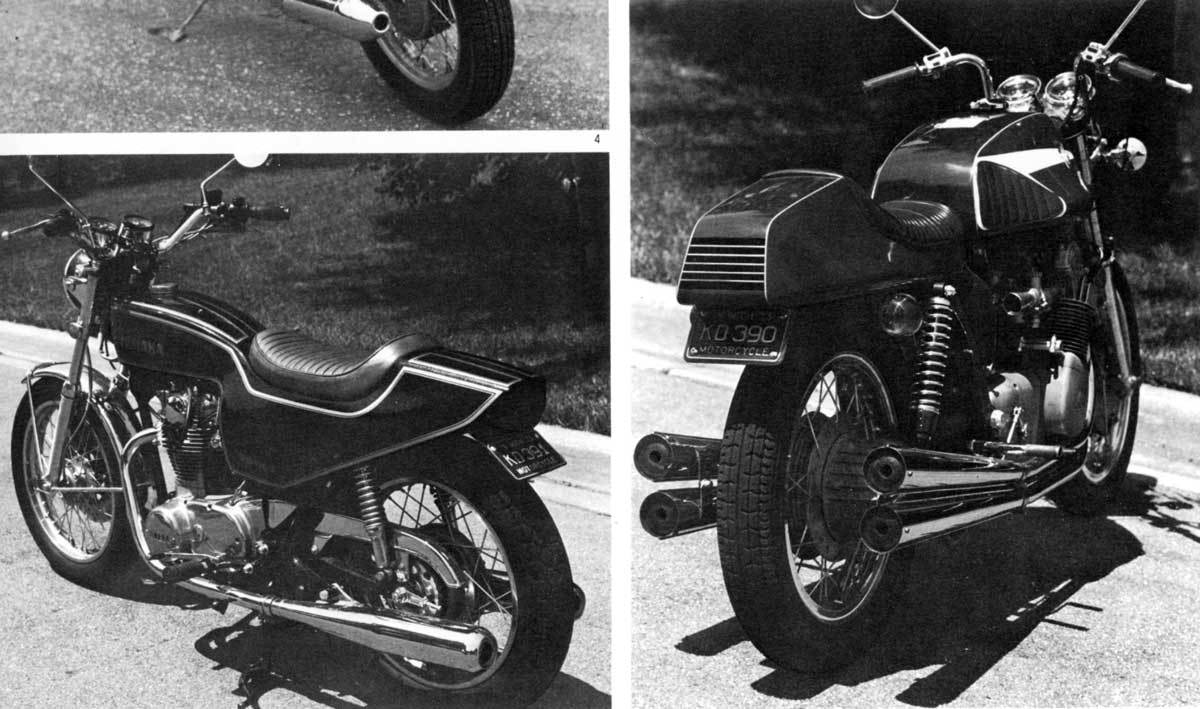
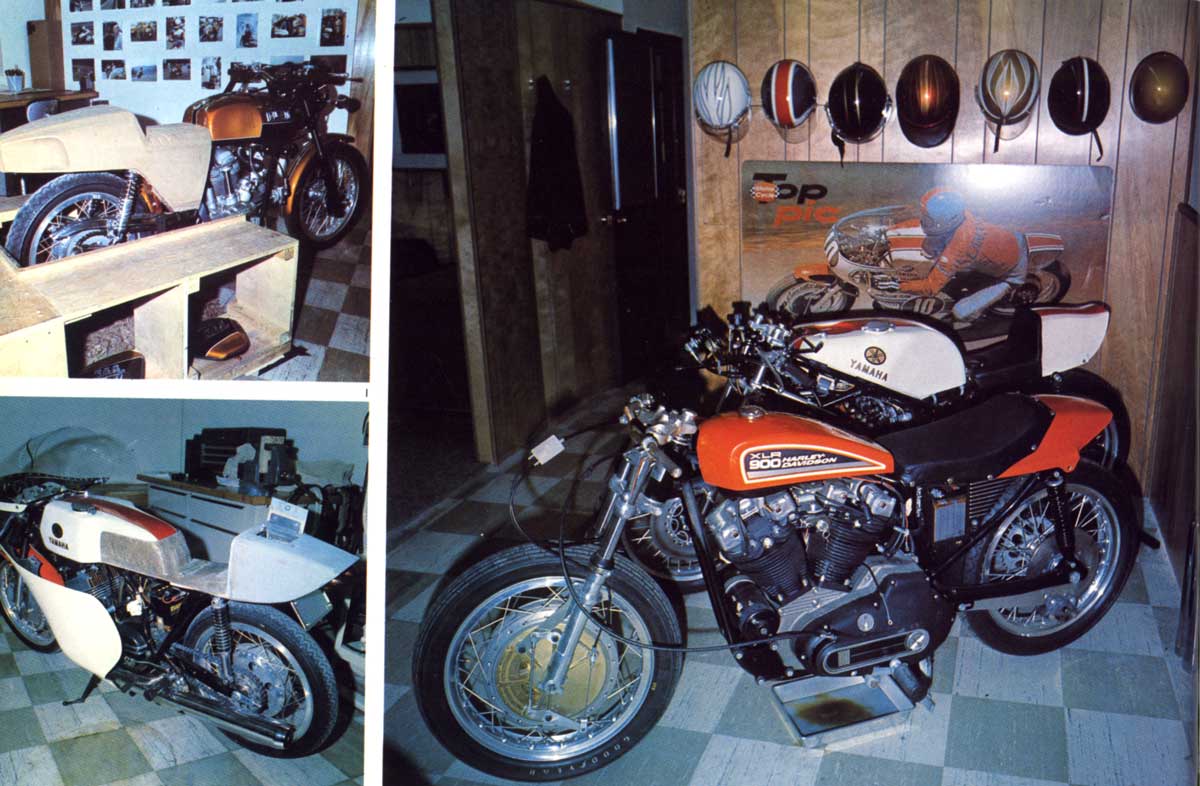
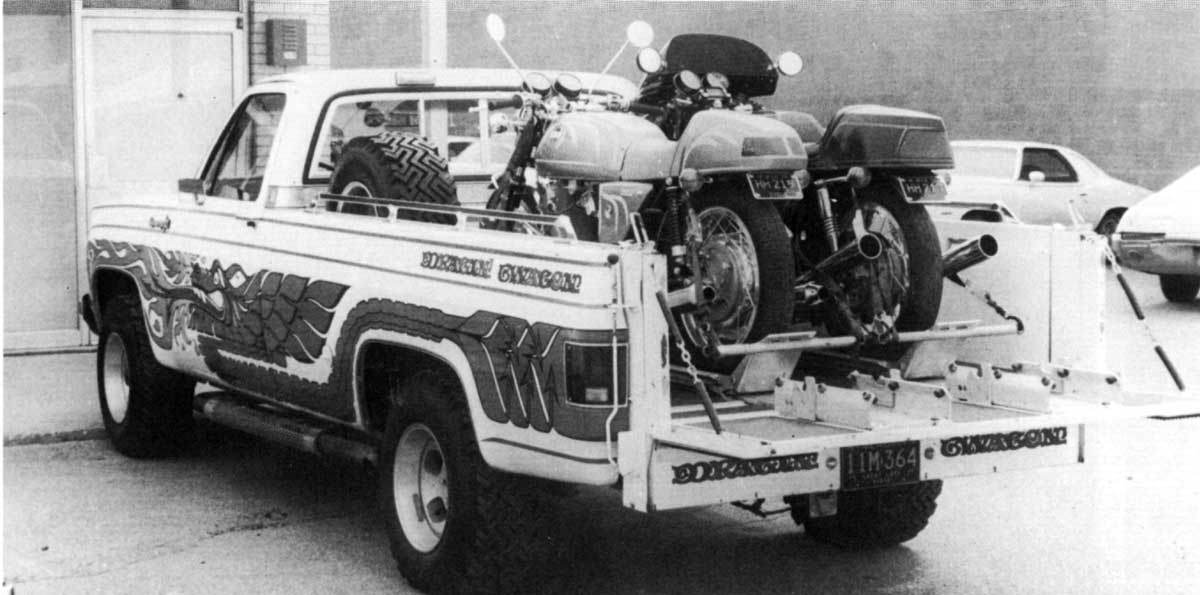
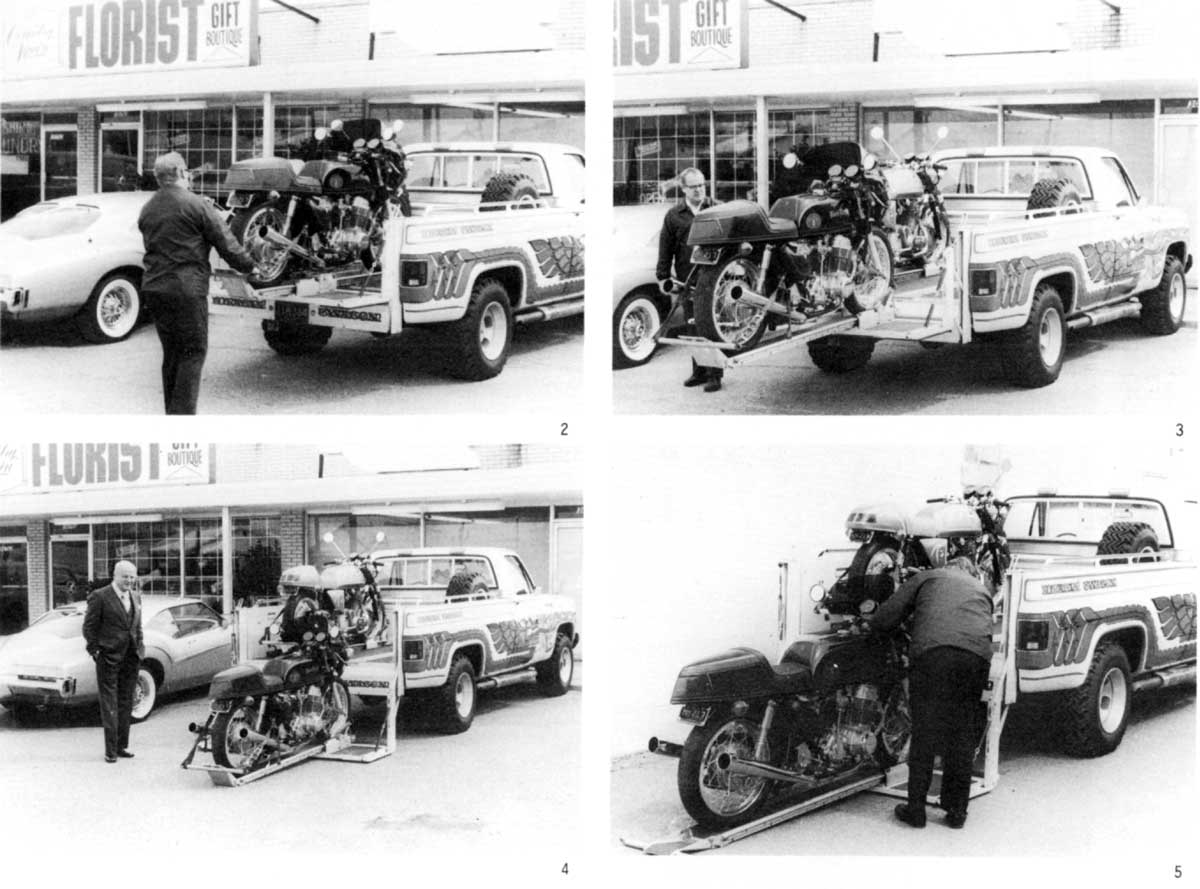
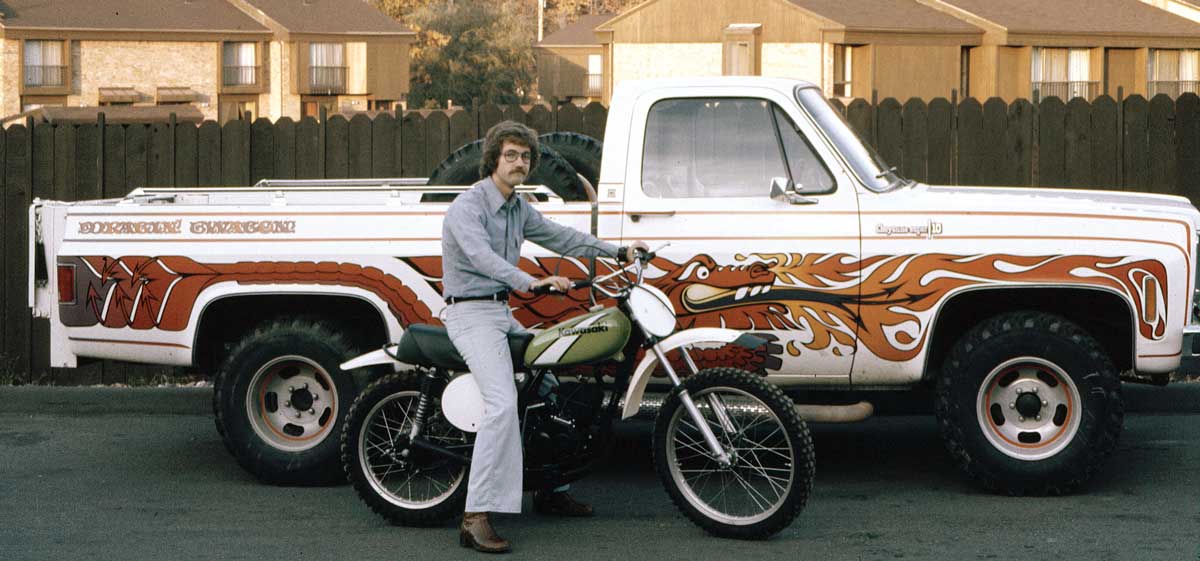
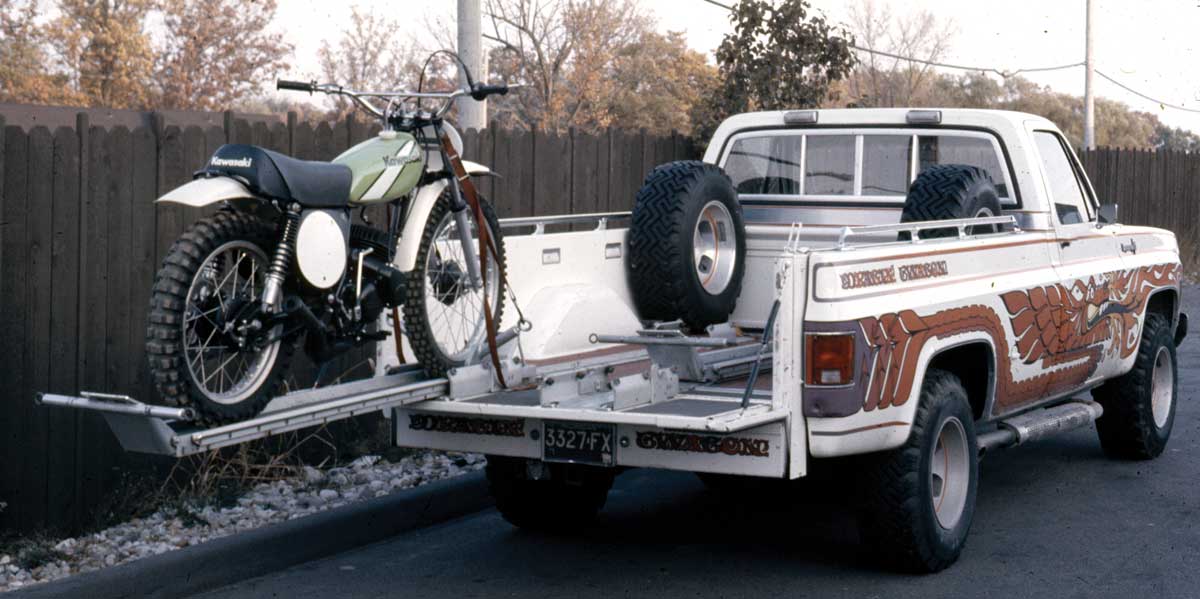
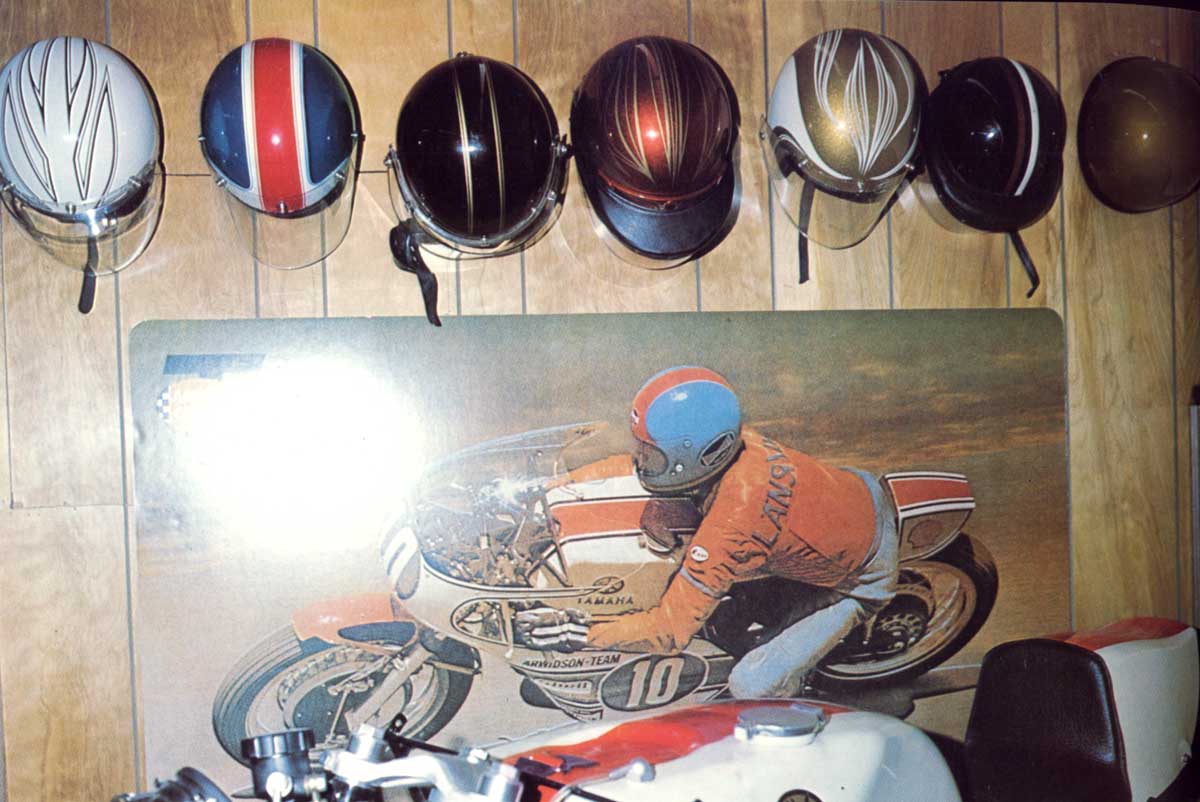
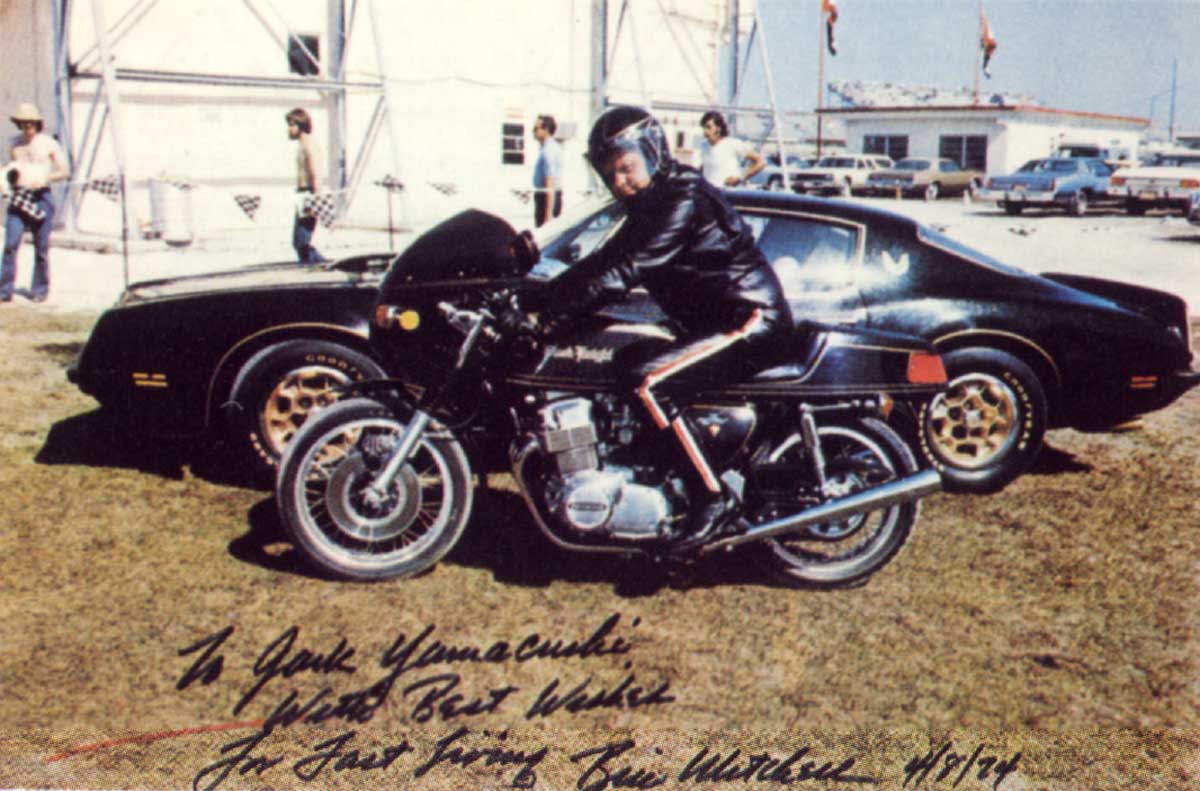
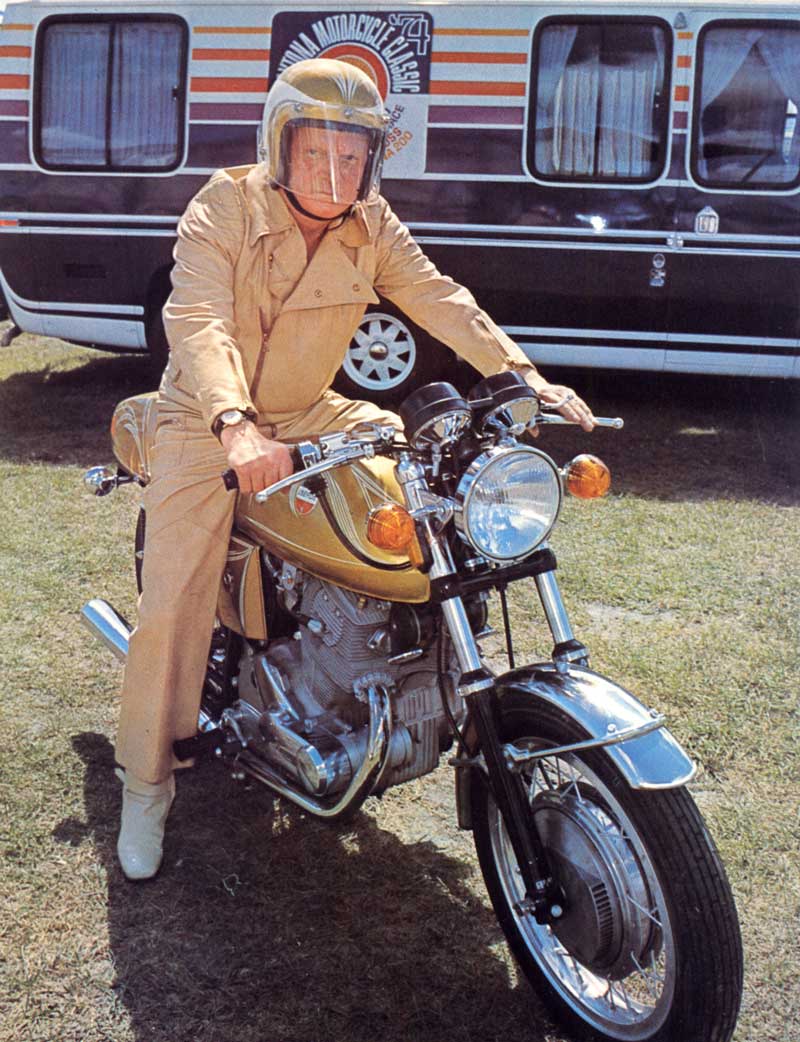
Excellent article! Missed one…I have the “Red Baron” which Bill customized. Its a 1977 BMW R100s with wings over the heads and inlaid brake lights in the tail. I have the matching red helmet as well. My Uncle worked at GM with Bill and bought it from him directly. Happy to share photos if you’d like.
I’m a big Bill fan, and of course of a generation that was given the gift of being able to own his designs when they were on the market, if sometimes slightly used…
But, why is it that his automobile designs are so timeless, even fifty and more years after the fact, and yet his motorcycle projects look so dated?
I’m a long-time motorcycle guy, with lots of variety in my new and classic rides and former rides. A VFR 1000, four Muth ’82 Katanas, Guzzi, BSA, MV Augustas, and currently two vintage Ducatis. There’s nothing in Bill’s two-wheeled aeuvre that I’d rather ride than any of the personal bikes I’ve cited, though. They all look too “full Cleveland” overdone.
Perhaps it’s the axiom that architects can’t design cars…witness Jeanneret’s and Wright’s attempts, as examples.
The “Dragon Wagon” is a revealing peek into Bill’s psyche, BTW! He and Frank Lloyd had more than a trifle in common, personality-wise, it seems.
Absolutely and completely a man of his times, the Hugh Hefner of the automobile ( and motorcycle) styling world. The FACT that he drove and made sure most were driveable GM “dream cars” would be enough – but his choices of a palette on two wheels emphasize even more what a man of his times he was. Once, and never again: Bill Mitchell. I used to think “those concept drawings” of GM cars were out of proportion – oh yeah? Mitchell actually had built a Riviera with extended fenders, just like the concept drawings! What a man. It makes me resent the fact that we revere so much Pininfarina but that Mitchell gets so much less hype, but deserves it…
Had always heard about Bill Mitchell’s styled motorcycles but nice to see a contemporary article about these.
A bigger question today is “Where are the motorcycles now?” Did they get sold off, used up, thrown out/scrapped, put into a Bill Mitchell collection, sold in his estate, given to a relative, etc.? Especially wondering about the Japanese models which would have had a lower value and interest in the late 1970s to early 1980s (versus the Italian or German motorcycles) due to the Japanese motorcycle over production glut in the early 1980s.
At the time this spread was published we were doing the Harley
Davidson “Sting Ray “bike with Bobby Knievel and Bill Davidson.
By far the best bike! Heard it sold in Vagas for a huge price!
This is wonderful!! I own the Yamaha TR3 that is shown being worked on. It’s actually a TR250 with an electric start R5 motor added. 1959 Cadillac tail lights molded into the tail. It’s wonderful to see it being worked on! Rumor has it that it was Kenny Roberts bike that he raced at Daytona in 1973 but I dont have a way to prove it. It’s a factory Yamaha production race chassis. Does anyone have any info on this? I also heard Mitchell designed a bike hauler for Kenny out of a front wheel drive GMC motor home. Maybe they did some horse trading?
The bike projects were not supported by GM ,they were
A private diversion from the bad time we were going thru
In the 70s! GM ,and Design staff had changed.
Please note that gear position indicators did not become even rare until years after these machines, much less common. I have eight motorcycles; only one (1985 Suzuki GS1150) has a GPI. Believe me, they ARE handy. I’d also love to know the parallel history of the Mitchell motorcycles and Tracy motorcycle bodies, i.e. which were first. I did, however, love the commenter who owns multiple Muth Katanas but says that Mitchell’s bikes were “overdone”. I’m a two-time Katana owner myself, and that’s hilarious!